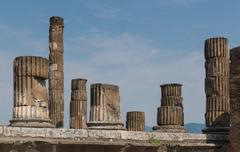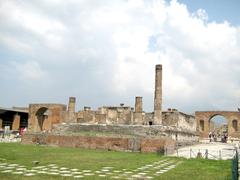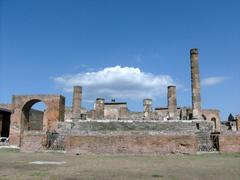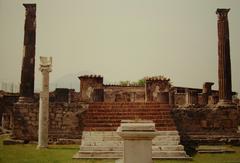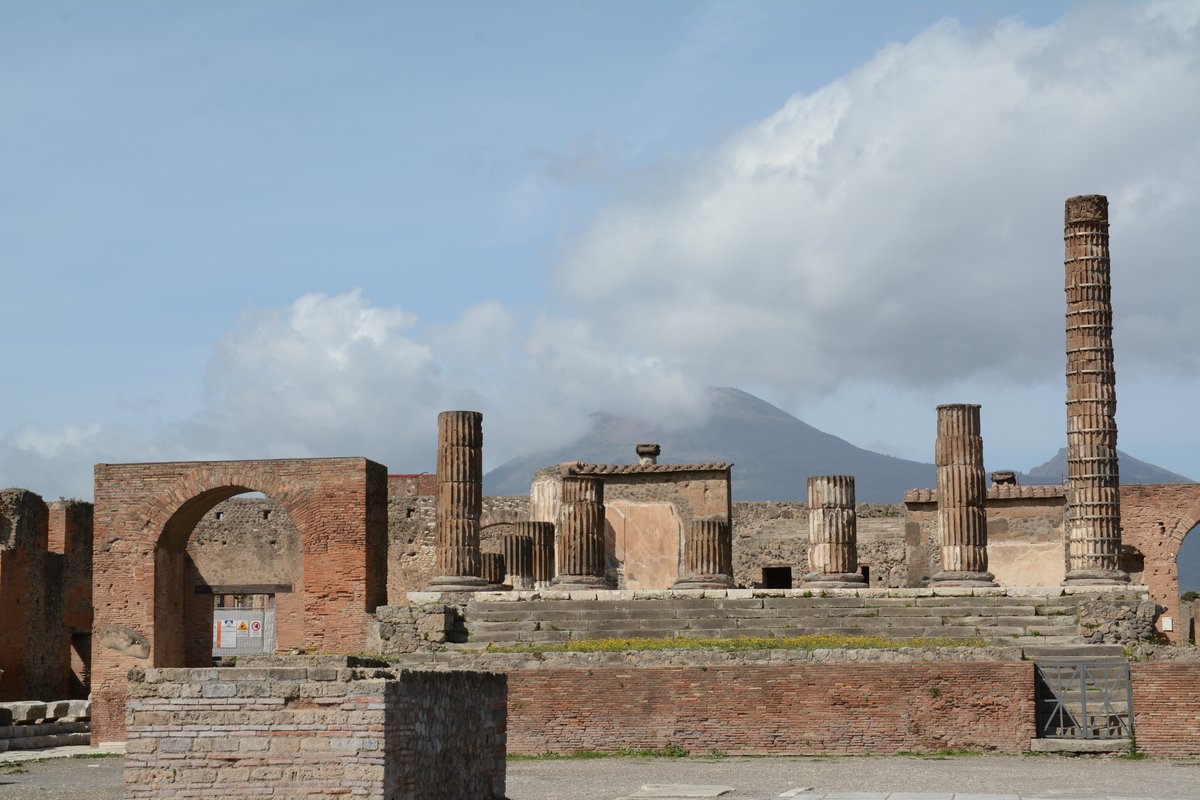
Temple of Jupiter Pompeii: Visiting Hours, Tickets, and Visitor Guide
Date: 15/06/2025
Introduction
The Temple of Jupiter in Pompeii stands as a monumental emblem of ancient Roman religious devotion and civic identity. Built in the mid-2nd century BCE, this grand structure was dedicated to Jupiter—the king of the Roman gods—and later also honored Juno and Minerva, forming the revered Capitoline Triad at the heart of Roman state religion. Its commanding position at the northern edge of Pompeii’s Forum symbolized both religious significance and the consolidation of Roman power in a city with Oscan and Greek roots.
Today, visitors can explore the temple’s impressive ruins—towering Corinthian columns, an elevated podium, and altar—all set against the dramatic backdrop of Mount Vesuvius. Ongoing archaeological excavations and modern preservation efforts, such as the Great Pompeii Project, ensure the site remains accessible and engaging. This guide provides essential information on history, architecture, religious and civic roles, and practical details for planning your visit—including ticketing, opening hours, accessibility, and travel tips. For the latest updates, consult official resources such as the Pompeii Archaeological Park website and expert travel guides like Cultured Voyages.
Contents
- Historical Background
- Architecture and Urban Integration
- Religious and Civic Functions
- Social and Cultural Impact
- Visiting Information: Hours, Tickets, Accessibility
- Tips for Visiting
- Visual Resources
- FAQ
- Key Recommendations and Conclusion
- References
Historical Background
Origins and Religious Context
The Temple of Jupiter (Italian: Tempio di Giove) is one of Pompeii’s most significant religious and civic structures. Erected during the height of Roman influence, the temple was dedicated to Jupiter and later expanded to honor Juno and Minerva, mirroring Rome’s Capitoline Triad (Adequate Travel). Before Roman colonization, Pompeii was influenced by Oscan and Greek cultures; the temple’s construction marked a deliberate assertion of Roman authority and identity.
Role in Pompeian Society
Beyond worship, the Temple of Jupiter was central to public life and civic rituals. It hosted major religious festivals, sacrifices, and ceremonies, reinforcing the bond between divinity and governance. The temple’s elevated position allowed it to dominate the Forum, visually asserting the supremacy of both Jupiter and Roman rule. After the 62 CE earthquake, the temple suffered major damage and was still under restoration when Mount Vesuvius erupted in 79 CE (Cultured Voyages).
Archaeological Discovery and Preservation
Excavations began in the 18th century, revealing the temple’s layout, construction, and decorative elements. Modern conservation initiatives, such as the Great Pompeii Project, have allocated significant resources for preservation, including the use of 3D scanning to monitor damage (Cultured Voyages).
Architecture and Urban Integration
Layout and Design
The temple exemplifies the Italic-Roman style: a high podium, deep pronaos (porch), and a cella (inner chamber) accessible by a grand staircase. Measuring about 37 by 17 meters, it was the largest religious structure in Pompeii (Adequate Travel). The orientation towards the Forum and the elevated podium reinforced its prominence.
Construction Materials and Techniques
Built from local tufa stone and faced with stucco imitating marble, the temple balanced durability with visual impact. The Corinthian columns were adorned with intricate acanthus leaf decorations. Although the original roof is gone, fragments of columns and capitals remain onsite.
Decorative Elements
While much decoration is lost, evidence suggests richly adorned interiors and exteriors. The cella likely featured painted stucco and marble revetments. Statues of the Capitoline Triad once dominated the cella, but are now lost; artifacts from the temple are displayed in the Naples Archaeological Museum (Cultured Voyages).
Urban and Civic Integration
Positioned at the Forum’s head, the temple was a visual and functional anchor, aligning with administrative and commercial buildings. The steps and podium enabled public addresses and ceremonies, and the open Forum allowed for processions and festivals.
Earthquake Damage and Restoration
The 62 CE earthquake caused severe damage. Archaeological evidence shows incomplete repairs at the time of Pompeii’s destruction in 79 CE, with visible scaffolding and temporary supports (Cultured Voyages).
Religious and Civic Functions
The Capitoline Triad and Ritual Practices
Dedicated to Jupiter, Juno, and Minerva, the temple was the principal religious structure in Pompeii, symbolizing the power and unity of Rome (Cambridge Amarantus). Rituals included annual games and festivals, public sacrifices, and offerings conducted by priests at the temple’s altar. The cella was reserved for priests and cult statues, while the general populace gathered in the Forum to witness ceremonies (Wikiwand).
Sacred Spaces and Offerings
Beneath the main hall was a chamber for sacrificial offerings and the city’s treasury, highlighting the interweaving of religious and civic responsibilities. The altar in front of the temple was central to public rituals (Wikiwand). Frescoes from nearby sites illustrate priests conducting sacrifices and worshippers—men, women, and slaves—gathered on the steps (Cambridge Amarantus).
Civic Importance and Political Symbolism
The temple’s placement at the head of the Forum made it the backdrop for political gatherings, speeches, and civic ceremonies (Google Arts & Culture). Its construction coincided with Roman colonization, and replacing Apollo with Jupiter as chief deity symbolized the imposition of Roman authority. The temple also served as a treasury, blurring religious and administrative functions.
Social and Cultural Impact
Festivals and Community Participation
Annual festivals and games in honor of the Triad promoted civic unity and showcased loyalty to Rome (Cambridge Amarantus). Priesthoods were often political, further blending religious and civic life.
Public vs. Private Worship
Public worship centered on the temple, while private worship occurred in domestic shrines (lararia) dedicated to household spirits and popular deities. Jupiter was rarely featured in homes, illustrating the distinction between state and personal religion.
Decline and Legacy
After the 62 CE earthquake, the temple’s importance waned. Restoration efforts were halted by the eruption in 79 CE. The smaller Temple of Jupiter Meilichios temporarily replaced it as the religious center (Wikiwand). Nevertheless, the ruins remain a powerful symbol of Pompeii’s past.
Visiting the Temple of Jupiter: Practical Information
Location and Access
The temple is centrally located at the northern end of Pompeii’s Forum. The site is easily reachable from Naples by train, car, or organized tours (Greca). Main entrances are Porta Marina, Piazza Anfiteatro, and Piazza Esedra (The Tour Guy).
Visiting Hours
- April 1–October 31: 09:00–19:00 (last admission 17:30)
- November 1–March 31: 09:00–17:00 (last admission 15:30)
- Closed: December 25, May 1, January 1
- Entry is free on the first Sunday of each month, but expect larger crowds (Pompeii Tickets).
Tickets and Entry
- Standard adult ticket: €16–€18
- Reduced rate (€2) for EU citizens aged 18–25
- Free for children under 18
- Purchase online or at the entrance; cash may be required at some offices (Greca), (Reddit)
Accessibility
While the Pompeii Archaeological Park offers accessible routes, the Temple of Jupiter sits on uneven terrain with steps. Wheelchair access is limited, but the Forum area is more navigable than other parts of the site.
Facilities
Restrooms, water fountains, and shaded rest areas are located near the Forum. Cafeterias and restaurants are near main entrances. Carry water and snacks, especially during warm weather.
Tips for Visiting
- Best Times: Early morning or late afternoon on weekdays, outside peak summer, to avoid crowds and heat.
- Footwear: Wear sturdy shoes for uneven surfaces.
- Sun Protection: Bring hats, sunscreen, and water.
- Guided Tours: Available onsite and online; highly recommended for historical context.
- Photography: Permitted for personal use; drones and tripods require permission.
- Respect the Site: Do not climb on structures or touch artifacts.
- Allow 30–45 minutes for the temple and Forum.
Visual and Interactive Resources
- View images and videos on official Pompeii websites and travel blogs.
- Interactive and downloadable site maps are available online.
- Virtual tours preview the site for remote exploration.
Frequently Asked Questions (FAQ)
Q: What are the Temple of Jupiter’s visiting hours?
A: 9:00–19:00 (April–October), 9:00–17:00 (November–March), closed select holidays. Last entry is 90 minutes before closing (Pompeii Tickets).
Q: How much are tickets?
A: €16–€18 for adults, €2 for EU youth 18–25, free for children under 18.
Q: Can I buy tickets online?
A: Yes, via the official Pompeii site and authorized vendors.
Q: Is the Temple of Jupiter wheelchair accessible?
A: The Forum is relatively accessible, but the temple podium and steps limit full access.
Q: Are guided tours available?
A: Yes, both in-person and audio tours are offered in multiple languages.
Q: Can I take photos?
A: Photography is allowed for personal use; special permission is needed for drones/tripods.
Q: What other attractions are nearby?
A: The Forum, Basilica, Macellum, Temple of Apollo, House of the Faun, Amphitheater, and Villa of the Mysteries.
Key Recommendations and Conclusion
The Temple of Jupiter remains a powerful testament to Pompeii’s religious, architectural, and civic legacy. As the centerpiece of the Forum, it reflects the city’s integration into the Roman world and its pivotal role in public rituals and administration. Despite earthquake and volcanic destruction, the ruins convey the grandeur and significance of ancient Pompeii. For a deeper experience, combine your visit with the Naples Archaeological Museum and consider a guided tour.
Prepare for your visit by booking tickets online, checking current hours, and downloading the Audiala app for personalized tours and updates. Respect the site’s heritage and enjoy an immersive journey into the heart of Roman civilization.
For further information, consult the official Pompeii website, Cultured Voyages, and Greca Travel.
References
- Adequate Travel
- Cultured Voyages
- Cambridge Amarantus
- Wikiwand
- Google Arts & Culture
- Amongst Romans
- Greca
- The Tour Guy
- Pompeii Tickets
- Reddit ItalyTravel

